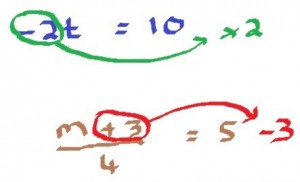Consider the following that I took from a student’s book. Is this something you have seen before? What do you think the student’s reasoning is?
What’s the Problem?
“Equations are easy sir”, says the Year 9 student, “you just grab a number, chuck it on the other side of the equals, and it changes sign”. So, in the first example the divide by negative 5 becomes a multiply by positive five, and in the second example the plus three gets magically transformed into a minus three. “Why does the minus five become a positive five, and why do you move the plus three first?”, the teacher dares to ask. “Dunno sir, leave me alone”.
What’s the Solution?
I have had many heated discussions with colleagues over this one. The problem is, of course, that the change side, change sign method works absolutely perfectly for a great number of equations. Indeed, students can sail merrily along through the world of Algebra right up to GCSE and this method will not let them down. Of course, as soon as they hit questions like the one above, or quadratic equations or algebraic fractions, then the boat starts to sink.
I have a two pronged attack for teaching solving equations. Firstly, I make sure students are happy with the order of operations. Students must be able to distinguish the second example above from . With Christmas still relatively fresh in the memory, I have found that talking about wrapping presents helps here. So, in the example above the m has first been wrapped up with a plus three, and then with a divided by four. So, when we are unwrapping the m to find out what it is, we need to deal with the divided by 4 first before the plus three.
Once students are happy with this and the idea of inverse operations, then I go down the route of the “balance method” where students record and carry out the same operation to both sides of the equation to keep things equal. So, in the first example above, students would divide both sides by negative two in order to cancel out the multiply by negative two.
I concede that it is likely to take students longer to be able to solve equations using this method, and some moments of frustration for all involved will lie ahead. However, it is undoubtedly more mathematically sound that whizzing things back and forwards across an equals sign and watching them magically change.
Craig Barton is an AST from the Bolton area. He is also the creator of www.mrbartonmaths.com and can be found on Twitter using @mrbartonmaths
Resources to help
Check out these resources and collections on TES which may help tackle to problem:
Topic Special: Solving Linear Equations – http://www.tes.co.uk/article.aspx?storyCode=6127212
Collection: Tarsia – Algebra Resources: http://www.tes.co.uk/article.aspx?storyCode=6109654
Algebra Study Units – http://www.tes.co.uk/article.aspx?storyCode=6088347
Equations (MEP – GCSE – Unit 10) – http://www.tes.co.uk/teaching-resource/Equations-MEP-GCSE-Unit-1O-6052193
Topic Special: Algebra – http://www.tes.co.uk/article.aspx?storyCode=6068949
